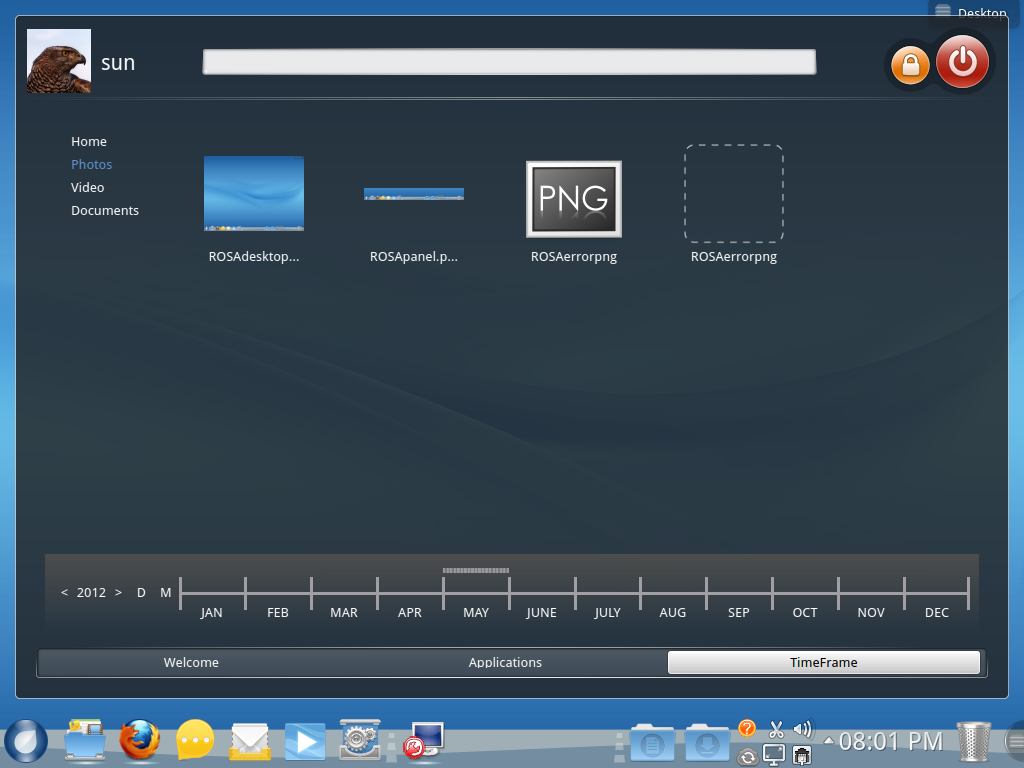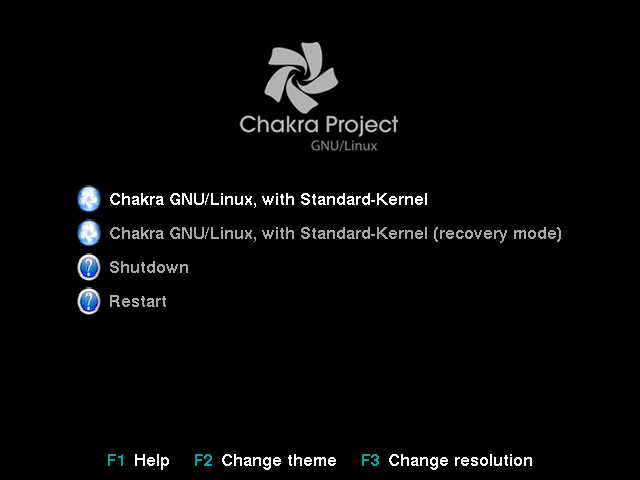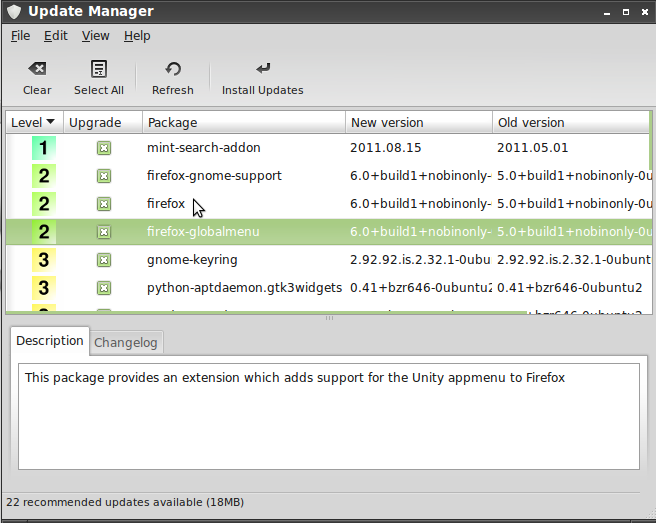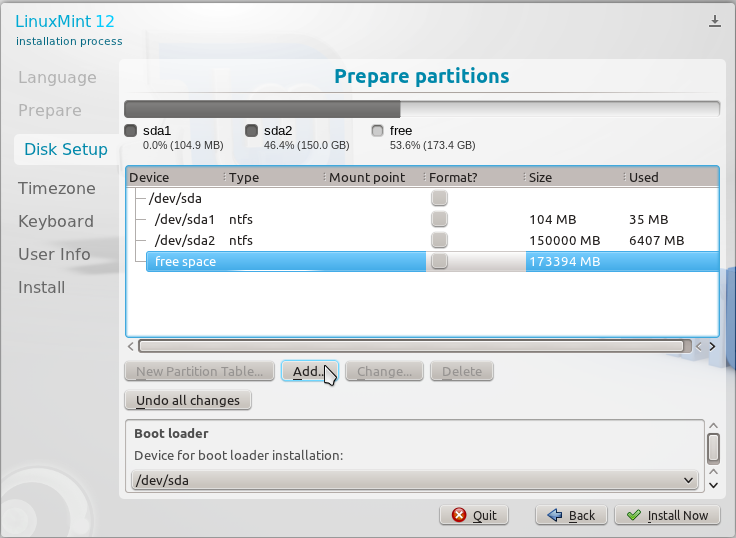Successful log in will bring you to the desktop, which s powered by KDE 4.8.2. If you have used Mandriva 2011 and have never heard about ROSA Marathon before seeing this screen shot, you will probably be thinking that you are looking at a screen shot of a Mandriva 2011 desktop. Other than the menu’s icon on the panel, they are virtually identical.
The panel (at the bottom of the desktop) is not the usual KDE panel, but what is know in ROSA parlance as a RocketBar. Like the KDE panel, it is made up of three parts – the left side contains static application icons, while the right side is the system tray. The space in between, is the task manager. However, it is not just called a task manager, but ROSA Tasks.
If you look closely at the RocketBar, you will notice that the icons are peeking just slightly above its top edge. Adjusting the height of the panel upwards does not make any difference. In fact, at a certain height, the icons in the system tray are displayed in two rows, instead of one, and may even underlap the date widget. But the problem does not appear to be with RocketBar itself, but with the location it occupies, that is, the bottom edge of the desktop

Because as shown in the screen shot below, if a RocketBar is added to the top, left or right edge of the desktop, the icons are well within its vertical dimension. If it is not already obvious, both panels are RocketBars.

To further confirm that the problem is with the location, not RocketBar, the same effect is seen when the RocketBar at the bottom is replaced with a default KDE panel. So, what is it about the bottom edge of the desktop? By the way, this issue is not unique to ROSA Marathon 2012. I have observed the same on Mandriva Desktop 2011. If a developer from ROSA Lab or Mandriva is reading, is this icon height thing with RocketBar a bug or “feature”?

A distinguishing feature of the ROSA desktop, is the menu. Like Takeoff Launcher, SimpleWelcome, as it is called, is a fullscreen menu, but with a few more features. It is made up of three tabs – Welcome, Applications and TimeFrame. More on the Applications and TimeFrame tabs on the last page of this review. The image below shows SimpleWelcome with the Welcome tab in focus. Though I like this menu, I think that the Places section of the Welcome tab is not really necessary. And that is because the StackFolder (more on it further down) already offers easier access to any file and folder in your home directory, or any directory that you add as a StackFolder. A better use for the Places section would be as a Favorites section, where you can add or pin your oft-used or favorite applications.
Though SimpleWelcome features a power button (and also a screen-lock button) in its upper right edge, clicking on the power button gives you just three options – Logout, Turn Off Computer, and Restart Computer. No Suspend or Hibernate. If you need to, how, then, do you suspend or hibernate a computer running ROSA Marathon 2012?

Another issue with SimpleWelcome, is that it begins to fall part at screen resolutions lower than 1024×768. The following screen shot shows what happens when the screen resolution is changed to 800×600. Not that I expect very many people, or anybody for that matter, to be using anything lower than 1024×768, but you never know, there are different types of users out there. You can clearly see the difference between this image and the one above.

On the RocketBar and just to the right side of ROSA Tasks, are two folders. These are known as StackFolders. They allow you to browse the contents of each folder without having to open Dolphin, the file manager. While I like StackFolders a lot (see 2 cool reasons to use the K Desktop Environment), I think it would have been better to add the user’s home folder as a StackFolder, rather than the Documents and Downloads folders, which are the ones you see on a default RocketBar. Adding the home folder as a StackFolder makes it easy to browse the contents of any folder, plus having one StackFolder instead of two, saves space on RocketBar. This image shows what my customized RocketBar looks like, after replacing the default StackFolders with one for my home folder. You may view one more screen shot of the StackFolder showing the contents of a specific folder on the last page of this article.

Though my first encounter with StackFolder was on Mandriva Desktop 2011, what makes the version of StackFolder in ROSA Marathon 2012 even better, is that it has KLook integrated. KLook, which I have written about elsewhere (see KLook: A Swiss Army Knife of media type viewers), is a multi-MIME- type viewer developed for ROSA Desktop/Marathon. With KLook, you can view a wide range of file types – audio, video, text and images (png and jpg), from the same application. It was only originally integrated with Dolphin, and now, also in StackFolder. What integration in StackFolder allows you to do, is view any file type supported by KLook right from the panel. To do that, navigate to the file, mouseover it and click the space key on the keyboard. The screen shot below shows KLook playing a video file straight from a StackFolder. When used from Dolphin, you can view/watch/listen to one or more selected files, but from a StackFolder, you can only view one file at a time. This applies to all supported files, including images.









Thanks for your review!
BTW, if you enable contrib repository – you can find Calligra Office Suite in it.
My impression from Rosa 2012: http://linuxblog.darkduck.com/2012/05/how-fresh-is-dew-rosa-2012-marathon.html
It is slightly different from yours…
Good indepth review. Keep up the Great work!
..or how about this, because that sentence doesn’t make sense without several re readings:
If it could not detect a copy of itself already on the drive, it was not surprising it couldn’t detect any distributions already present on the hard drive, even on the partition targeted for installation.
no wider — you mean “no wonder”
cheers,
John
Thank you, feedback of this sort is a good thing.